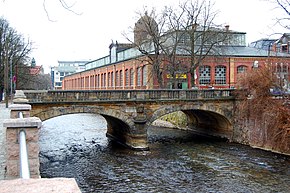Beer bridge
The beer bridge in Chemnitz is located near the market hall at the foot of the Kaßberg . It spans the Chemnitz River and was named as early as the 16th century, as it was through it that the freshly brewed beer was brought to the "Caßperge" storage cellars until 1778.
background
With the introduction of and compliance with the Purity Law of 1516 in Bavaria, bottom-fermented lager also gained importance beyond the Bavarian borders. The new brewing method of beer required a cool and longer storage. This was not possible in what was then the city, so cellars were created in the Kaßberg. In the floor book of the city of Chemnitz in 1531 taxes for six cellars in the Kaßberg were shown. In 1536 the city council built its own cellars in the Kaßberg. In the same year the wooden cellar bridge was converted into a stone beer bridge . In the following years, more cellars were dug into the Kaßberg. In 1538 Georgius Agricola followed the excavation of the beer cellars with particular interest , and he also carried out investigations into the Chemnitz rock.
In 1676 the beer bridge was renewed because it had been "lying down" for 40 years. In 1694 it was destroyed by floods and only rebuilt in 1710. Half a century later, the bridge was "torn away" when the ice fell in 1768 and then rebuilt. In the same year, the Chemnitz brewing citizens had their last documented "beer battle":
“Also in that year the last beer battle of the local brewing citizens was delivered by taking away half a ton of Dittmannsdorfer beer from the pastor of Röhrsdorf, which pastor Knecht wanted to deliver to his master. The beer had run out in the fight that eight waged against one and now the servant, who had been beaten almost to death, had to be driven home on the wheelbarrow instead of the beer. The pastor, however, brought a lawsuit and the eight people from Chemnitz were each given 4 weeks' imprisonment and 10 thalers. Penalty except litigation and health resort costs. "
In 1778, the state government of Electoral Saxony issued a new brewing and serving regulations, in the course of which the brewing of lager beers was stopped and the breweries no longer needed the lager vaults.
The bridge in its current form was built in 1868/69. On the barely recognizable city arms in the middle of the beer bridge, the lion, in contrast to today's city arms, looks to the right to the edge of the arms. Another renovation with reinforcement should take place in 2008.
Individual evidence
- ^ Julius Theodor Pinther, Chronicle of the City of Chemnitz and Surroundings, 1855.
- ↑ Money for building bridges remains in the official channels ( page no longer available , search in web archives ) Info: The link was automatically marked as defective. Please check the link according to the instructions and then remove this notice.
literature
- Adam Daniel Richter Complicated Chronica of the Chrurfürstlich Sächzische Stadt Chemnitz at the foot of the Meißnischen Ertzgebürges, compiled from reliable news, together with enclosed documents. Verlag Schöpfische Buchhandlung, 1764, Zittau and Leipzig, part 1, p. 41, ( online )
Web links
Coordinates: 50 ° 50 ′ 4 ″ N , 12 ° 54 ′ 54 ″ E
